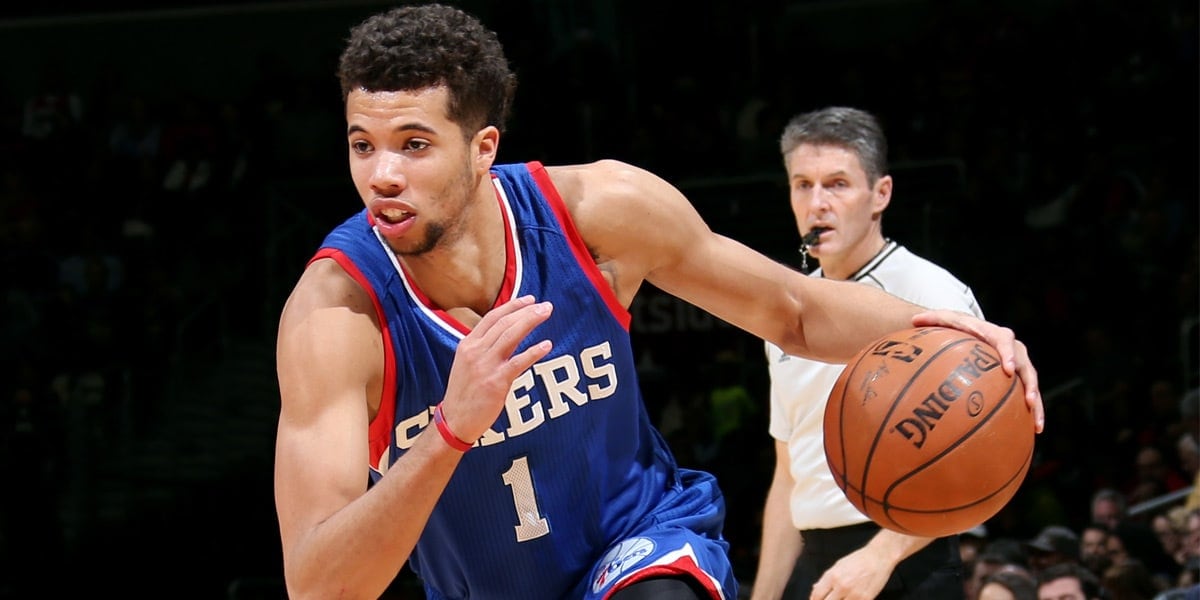The Life and Times of Carter-Williams Vol. 2
The plan is, in a year or two, stories about him won’t start like this one is starting: “In his very first NBA game, Michael Carter-Williams beat the defending champions. He almost had a triple-double and almost had a quadruple-double (22 points, 12 assists, 9 steals, 7 rebounds). In his first night in the league, he was just as good as LeBron on the same court, except a little better.”
***
For now that is fine. Soon it will not do. Because here in Milwaukee, here in the 2000s, we have witnessed sparkly young point guards who saved some of their best for first. Carter-Williams needs to grow. No one ever really knew how good he was with the 76ers, the best team at being the worst team in the NBA since he arrived. Sometimes he was great. Sometimes he was just a player on the worst team out there. And so here we are again. The return of the Experimental Year* we all expected (*playoffs now included). Well, Carter-Williams did not expect this or that.
***
Carter-Williams easily won Rookie of the Year last season. Everyone had a grand time saying the draft class was not very good, but his traditional per game numbers were exceedingly good for a rookie: 16.7 points, 6.2 rebounds, 6.3 assists, 1.9 steals. He was on a very bad team, but he was legitimately the best or second-best player on that team as a rookie, even with solid efficiency numbers, including a 15.5 PER (for a reference point, Jabari Parker was at 14.6 before going down with an injury this season). Carter-Williams posted a couple triple-doubles, started all 70 games he played, had a ton of responsibility – too much really – and was the best player in his draft class.
***
Speaking of that class. If we did another 2013 re-draft now, Carter-Williams is still one of the five most prized prospects in that 2013 draft class, in some order along with Giannis Antetokounmpo, Victor Oladipo, Rudy Gobert and Mason Plumlee. Right? This is the time to point out that the Bucks also received Miles Plumlee in the trade, who is not the same person as Mason Plumlee. The only way you would ever really remember the difference between the two is if one (but not both) played for the Bucks. Here we are, and here is something that Andrew Sharp at Grantland wrote about the Plumlees (plural) some months ago:
***
Back to Carter-Williams and his sophomore year, this year. His traditional and efficiency numbers have mostly straight-lined or even dipped, and that matters. His shooting numbers (never very far up) in particular are down. But again, the 76ers are now a team whose second-best player might be Luc Mbah a Moute. A team that just signed Tim Frazier to a second 10-day contract. Carter-Williams regularly played point guard with two or three NBA-level players at his side. Now we are over here talking about Tim Frazier.
***
Life is going to make us wait a little to see Carter-Williams play for the Bucks. Very life of life to do that. He has missed the last three games with a sore right foot, and he might miss a few more.
***
When he suits up for the Bucks, he will offer a very different set of strengths and weaknesses than Brandon Knight. The next two paragraphs respectively are about what he needs to keep doing and what he needs to start doing, in order to be the point guard of the future.
***
First, keep playing defense and creating turnovers. Like the Bucks, the 76ers improbably made a huge leap on the defensive side this season, now ranking 12th overall in defensive efficiency, right in between the Pacers and Bulls. Carter-Williams ranks second on the team in minutes, and some of his advanced defensive metrics (such as Defensive Real Plus-Minus, where he ranks second best among NBA point guards) are among the best in the league. The Bucks thrive in transition on both sides of the ball, and Carter-Williams collects a fair number of steals and finishes at the rim very well, at 62.7 percent.
Here are the 10 best point guards in the NBA this season in terms of field goal percentage at the rim:
- Stephen Curry – 69.0 percent
- Darren Collison – 68.4 percent
- Kyle Lowry – 67.3 percent
- Eric Bledsoe – 65.5 percent
- Damian Lillard – 65.2 percent
- John Wall – 65.2 percent
- Jeff Teague – 64.0 percent
- Ty Lawson – 63.5 percent
- Michael Carter-Williams – 62.7 percent
- Mike Conley – 60.8 percent
That means he also finishes at the rim at a better percentage than Kyrie Irving, Brandon Knight, Russell Westbrook, Derrick Rose, Tony Parker, people like that. That is his comfort zone for now. He is at his best either getting to the rim or setting up teammates. His assist percentage is up this season from last, all the way up into the top-5 of the league, just behind Chris Paul and just ahead of Rajon Rondo. Swell company. He is also one of the best rebounding point guards.
***
The list of things that Carter-Williams must improve in order to be the point guard of the future is not short. This is partial. It includes things like shooting from the mid-range, shooting free throws, shooting threes, shooting from absolutely everywhere on earth, getting to the line more often, and really honestly really limiting turnovers.
***
